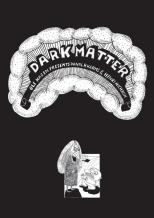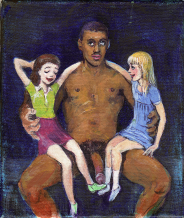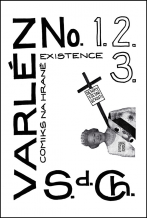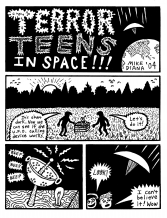| Umělec magazine 2010/1 >> KASSABOYS: Cosmopolitan Local-Patriots | List of all editions. | ||||||||||||
|
|||||||||||||
KASSABOYS: Cosmopolitan Local-PatriotsUmělec magazine 2010/101.01.2010 Lenka Kukurová | profile | en cs de |
|||||||||||||
|
Three artists make up the Kassaboys. The group’s part catchy-pop, part local-patriotic moniker is a reference to their hometown, Košice, Slovakia. The “boys of Košice” are Radovan Čerevka (b. 1980) Tomáš Makara and Peter Vrábeľ (both b. 1982). Their art collective is one of several products of a very strong graduating class from the Faculty of the Arts at the Technical University of Košice, also known as FUTU.
The Faculty of the Arts was established in 1998, and employs a highly qualified and experienced faculty. Artists Juraj Bartusz, Rudolf Sikora, Dušan Zahoranský, and curators Vladimír Beskida, Mira Putišová, and Peter Tajkov have long taught and mentored students there. At FUTU, the young Kassaboys attracted attention on the Slovak art scene early on in their studies, earning praise as remarkably established young artists. Their collective work was first featured in the exhibition “East of Eden,” curated by Diana Majdáková and Juraj Čarný, which premiered in 2007 at the Space Gallery in Bratislava and later ran at Kultur Park in Košice, and Karlín Studios in Prague, in 2008. However, the rise of a strong art scene in Košice, represented by the “East of Eden” exhibition and by the winners of the Slovak contemporary Oskar Cepan Prize, has raised questions about the importance of a common regional orientation for the Kassaboys and their peers. Despite the natural influence these young Košice-based artists have had upon each other—often appearing in each other’s work, for example—there exists little of a common, regional orientation or thematic resemblance between their works. In 2006, as a result, the Kassaboys diverged from the young scene in Košice to form their own group, connected by their inclination towards political commentary and the exploration of their own artistic efforts. This group can also be distinguished from their peers by a unique particularity. As evidenced by the name itself, the Kassaboys often have a strong sense of place in their work. The political piece is inevitably site-specific, and tied to both its local and historical contexts. In the case of the Kassaboys, Košice inevitably inspires the work and opinions of the collective, in both conscious and unconscious ways. To understand what it feels like to be a “kassa boy,” one must understand their context. In Košice, history is inescapable—the cathedral and ancient high streets dominate the town’s center. However, socialism turned the Hungarian city of culture into an industrial hub, which led to a period of cultural vacancy. Thus, Košice is a place of contradictions characterized not only by its historical center and industrial periphery, but also by its polarized social life. Social life may continue amid the city center’s historical decor, but the city has lost its privileged position as a cultural center. Košice has gone through periods of fame: it received the first coat of arms known to be bestowed upon a city, the Hungarian writer Sandor Márai was born there, and the late national hero František Rákoczy II is buried there. It is marked in art history as the birthplace of a distinct form of modernism (kosicka moderna). Still, despite the fanciful façades of renovated buildings lining its streets, the city is affected by a strong feeling of being on the periphery of cultural life. The main cultural life of the city thus revolves around an idiosyncratic group of characters: the folkloristic comedian Ander of Košice, the reality show-starring Mojsei family, the former president of Slovakia and mayor of Košice Rudolf Schuster (known also for his anaconda-hunting and singing of Slovak folk songs). Rebelling against this cultural majority, the Kassaboys sought to organize an alternative cultural life for their city. These intentions are made clear in the Kassaboys’ manifesto, in which they state: “We admit that we work with concepts like local-patriotism and centralism ... or with the legendary archetype of a tragic artist working from the periphery.” The notion of the periphery in the work of the Kassaboys is multifarious. On the one hand, it is their connection to Košice, a city that has been “at the other end of the republic” from the time of Slovakia’s foundation, a position that places it on the geographical and political periphery. On the other hand, they undoubtedly remain conceptually and artistically on the periphery of the general public’s interest. The first pieces the Kassaboys created collectively were a series of videos shown on Slovak Television for the show Art. They were first broadcast as fictitious TV news programs, but now can be viewed as individual works. The first three videos present the Košice art scene within the frame of the Kassaboys’ own artistic community1. The first piece, From Kassa (2006), starts with dramatic shots of Košice as a cursed city of ghosts, where rats roam through unsafe exhibition spaces. These shots are then spliced by news footage, in the style of a live telephone interview. Artists from Košice are shown drunk or with black eyes, symbols perhaps of their burdensome destiny. This is also illustrated by a shot of a person lying in front of the “running” statue of Julius Jakoby—taken from the vantage point of a local bar popular among artists. The telephone conversations, spoken in a strong east-Slovakian accent, emphasize the migration of the new graduates away from Košice, again pushing towards the periphery, both physically and conceptually. The video operates within these clichés—the vanity of artistic effort, the migration outwards, and the East as the “end of the world”. A few shots in the video come from two “guerilla” events organized by the Kassaboys: in one, a man dressed as a peace dove runs in a marathon, and in the other an image of Prime Minister Fico is plastered to the face of a climbing advertisement dummy. The tone of the Kassaboys’ work is largely ironic and self-effacing. From Kassa has an amateur feel to it, looking more like a classroom prank than an established newscast. Its appearance on television, however, casts the work in a new dimension. It distorts the traditional character of the news, openly revealing subjectivity and manipulation—operating simultaneously as a visual contrast and a critique. The second video, Plea (2006), was created in collaboration with the artist Viktor Freš. It records a religious service held by Košičan artists for artists in a local Franciscan church. They participate in the sacrament as acolytes, stating, “Lord, on behalf of all the artists inspired by you, please let them hold to their ideals despite all difficulties.” The service recalls desperate times throughout history in which Slovak people turned to God in need. Interestingly, in this project, the Kassaboys and their colleagues abandon the clerical issue reflected in works by Tomáš Makara or Matúš Lányi. Their sarcasm is instead directed toward habitual national passivity and the common expectation that solutions should come from “somewhere up there.” The last of the three videos, Harmony of the soul (2006), was never broadcast due to ethical reasons and marks the end of the Kassaboys’ stint as news reporters. Here, shots of young Košičan artists’ exhibitions in the Museum of Vojtech Loffler are accompanied by a verbal commentary intended for an exhibition by mentally ill artists held in another East Slovakian city. As the commentator describes how these artists “color pictures at home” and assures us that “it would be a shame not to see these little works of art,” the parallel becomes clear—for the average Slovak public, there is not much difference between the two exhibitions. Artistic creation without financial motivation is commonly understood as irrational, if not “crazy.” An exhibition of contemporary art usually fails to elicit understanding, but an exhibition of the works of patients can at least evoke sympathy. In Harmony of the Soul, both groups are equally marginalized. Rather than leaving Košičan cultural life to the prayers of the people, the Kassaboys and company have taken active leadership in the organization of art events in their city. Their videos, therefore, present not only their own activities, but activities they have promoted and often participated in. The work Symposium (2007) is one such project. It took place at Žilina Station (Stanica v Žiline), and was presented at the fourth Prague Biennale as a video installation. For this piece, the Kassaboys organized a “symposium” to which they invited a painter, a sculptor and a graphic designer to come and create a work each in real time from a live model of a female nude. The symposium took place in an antique interior adorned with fruit baskets, draperies, a daybed and a podium. In addition to the artists, three art theorists were invited to attend. Mira Putišová lectured on contemporary sculpture, Poláčková on painting, and Diana Majdáková on graphics, The lectures took place while the works were being created, with the academics carefully dressed in safety garments. In the text accompanying the project the Kassa-boys explain: “the classically designed symposium space has thus become a union of contemporary theory and classical artistic creation, or the image of it.” The participating artists—the sculptor Vlado, painter L’ubo and graphic artist Mat’o (together with muse, Erika)—can be said to have a traditional attitude towards art. Their task was equally traditional. The project culminated with a performance by Mario Chromý, a musician formerly of the band Iné Kafe, who was invited specifically to work on the project with the Kassaboys. He sang about the artists involved, interjecting ridiculous anecdotes between each song. The resulting effect was not, as one might guess, a parody of the work of the artists involved (who presumably, if only vaguely, guessed the purpose of the project from its beginning), but a parody of the artist’s situation in society in general. The piece ridicules the participating artists’ creations insofar as they belong to the category of “art” in the eyes of a wider public. In Slovakia, the general public appreciates artwork featuring the classical female nude far more easily than contemporary art. The Kassaboys thus place themselves ironically in the role of misunderstood, tragic heroes of the art world—a role that they often take on in their work. Symposium has many elements—it can be understood as an excursion into the history of art up to the present day, or as an examination of lingering artistic traditions and the value of craftsmanship. At the same time, the work parodies itself. It is presented as a video installation, but in reality it is a record of an event taking place in an environment. The result is a hybridization of form that contradicts the understanding of art as an exceptional, artisanal product. Authorship is also made problematic—the Kassaboys as authors are, in the end, “only” the collective organizers (though they do state their individual names as credits). The question remains open as to who is the main artistic celebrity, and who should get credit. The gender issue cannot be overlooked when speaking of art collectives. The fact that the Kassaboys are an all-male collective is more situational than intentional2. Apart from Symposium, their projects remain largely removed from issues of gender. Still, in contemporary interpretation, the subject of a woman as model and the female nude brings up questions of the woman as subject or object in the history of art. But the Kassaboys have balanced this issue—unconsciously or intentionally. The participants and organizers of Symposium were male and the model was female, but the theoretical background was provided by three female theorists who, in this case, had the last word in the piece. The Kassaboys’ first exhibition, Kassaboys Museum, was created for the Box space, part of the gallery NoD in Prague, at the end of 2008. This time, the subject of the show was not the situation of the artist in society, but rather it was a direct reaction to the politics of Hungarian-Slovak relations at the time. The Kassaboys literally illustrated racist statements that Ján Slota, a Slovak nationalistic politician, had used to address the country’s Hungarian minority. Slota called Hungarians “mongoloid types with crooked legs,” and characterized the mythical Hungarian bird Turul as “a repellent and disgusting parrot.” For Slota, St. Stephan was “a clown on a horse” and the Hungarian foreign minister a “raggedy wretch.” These remarks—not the work of a barstool demagogue but an active politician from a parliamentary party—incited a strong reaction from the Kassaboys. The artists exhibited their illustrations formally, with a red carpet and each piece presented on a plinth. The Kassaboys described the show as “a cabinet of curiosities ... the visual side communicates best with the spectator, while the labels are Slota’s quotes. The form refers to the tested principle of demonizing political opponents that has been repeated throughout history. It is something that belongs to a museum, in the same way that Slota’s ‘revolutionary’ rhetoric is a surviving relic from the past.”3 The exhibition does not play with meanings, and its satiric effect is clear. The Kassaboys explain, “The exhibition has a bold effect because this type of expression does not need to be obscured by many layers of rhetoric. By using a simple method of presentation we reveal the bizarre quality of Slota’s words. Slota usually communicates as a folk narrator—he invokes the imagination to produce images. His opinions are simple, and he presents them to people as fairy tales—this engenders popularity. We have materialized these images and creations—and their inner racist phobias.” In this project, the reference to the origin of the group is implied. In Košice, a city with quite a large Hungarian minority4, the prospect of Slovakian nationalism is unlikely, even amusing. The declared local patriotism of The Kassaboys has a character thoroughly unlike nationalism—instead, it is rather cosmopolitan. The artists met Slota at the exhibition “Hrach o stenu hadzat” (Beat the Wind) at Station in Žilina-Zariecie in 2006. There, they were not exhibiting collectively, but as individual artists. The exhibition took place in the gallery as well as publicly, in the form of billboards. It was the mark of the Kassaboys’ artistic contribution to the local election for mayor when, after many years, Slota was defeated as the mayor of Žilina. During the private viewing of the exhibition, Peter Vrábel performed. The performance was an apt one for the Kassaboys’ political message—Vrábel swore while watching TV news and while measuring his own blood pressure. Local patriotism is also visible in the logo of the Kassaboys—the eagle of Košice, in cameo trousers, holds its index finger high while the Bratislava Castle burns behind its back. Again, the image of an artist working on the periphery is evident. The Kassaboys comment: “It is necessary to fight hard for the attention directed mostly at Bratislava. You can compare it to habits of the NHL, where a foreigner can succeed only if he is better than the local players.” 1 The videos can be seen at: http://www.kassaboys.euweb.cz/kassa_boys.html. 2 A sort of a female counter-parallel was the exhibition “Three graces” (Lucia Dovičáková, Jarmila Džuppová, Vlasta Žáková, Station, Žilina-Záriečie, 2009) 3 The quotes are from an interview about the exhibition made for the daily Sme that, for unknown reasons, was never published. 4 Before 1918, Košice was mostly Hungarian city, where Ukrainians, Poles, Germans and a Jewish minority lived alongside Slovaks. 1 The videos can be seen at: http://www.kassaboys.euweb.cz/kassa_boys.html. 2 A sort of a female counter-parallel was the exhibition “Three graces” (Lucia Dovičáková, Jarmila Džuppová, Vlasta Žáková, Station, Žilina-Záriečie, 2009) 3 The quotes are from an interview about the exhibition made for the daily Sme that, for unknown reasons, was never published. 4 Before 1918, Košice was mostly Hungarian city, where Ukrainians, Poles, Germans and a Jewish minority lived alongside Slovaks.
01.01.2010
Recommended articles
|
|||||||||||||
|
04.02.2020 10:17
Letošní 50. ročník Art Basel přilákal celkem 93 000 návštěvníků a sběratelů z 80 zemí světa. 290 prémiových galerií představilo umělecká díla od počátku 20. století až po současnost. Hlavní sektor přehlídky, tradičně v prvním patře výstavního prostoru, představil 232 předních galerií z celého světa nabízející umění nejvyšší kvality. Veletrh ukázal vzestupný trend prodeje prostřednictvím galerií jak soukromým sbírkám, tak i institucím. Kromě hlavního veletrhu stály za návštěvu i ty přidružené: Volta, Liste a Photo Basel, k tomu doprovodné programy a výstavy v místních institucích, které kvalitou daleko přesahují hranice města tj. Kunsthalle Basel, Kunstmuseum, Tinguely muzeum nebo Fondation Beyeler.
|








































 New book by I.M.Jirous in English at our online bookshop.
New book by I.M.Jirous in English at our online bookshop.
Comments
There are currently no comments.Add new comment